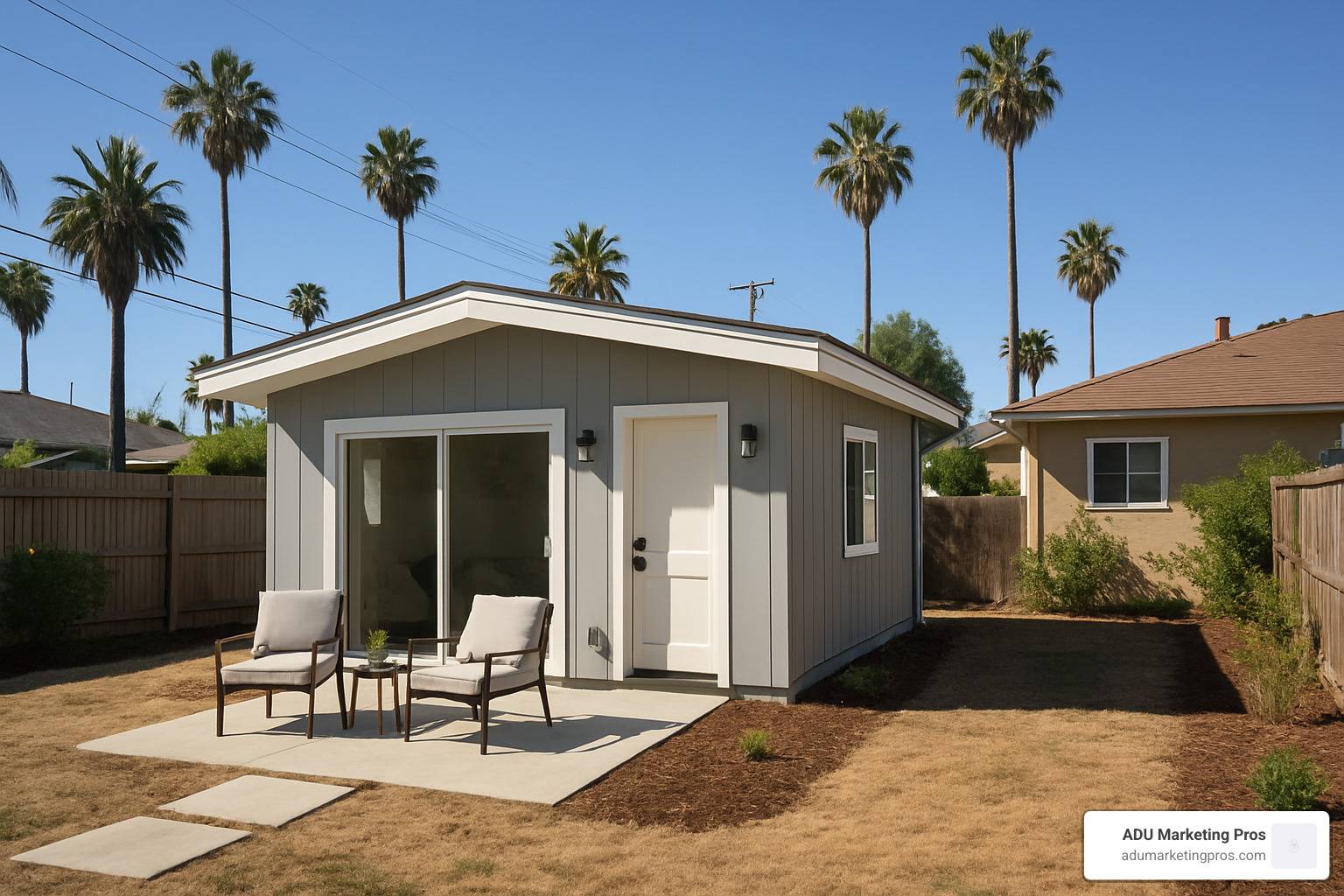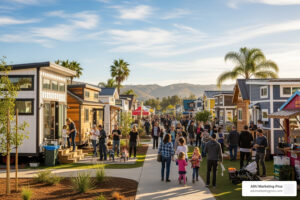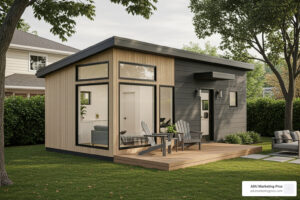Why Building an Affordable ADU in California is Within Your Reach
Affordable ADU California projects are becoming the go-to solution for homeowners facing the state’s housing crisis. With average ADU costs ranging from $75,000 to $250,000+, smart planning can keep your project well below six figures.
Quick Answer for Affordable ADU California Options:
- Garage conversions: $35,000-$60,000 (cheapest option)
- Room conversions: $40,000-$70,000 (basement/unused space)
- Prefab ADUs: $50,000-$100,000 (fastest timeline)
- DIY kits: Under $45,000 (most affordable with sweat equity)
- Fee exemption: ADUs under 750 sq ft save $5,000-$20,000 in impact fees
California’s housing shortage has pushed home prices to record highs, making accessory dwelling units a practical alternative. State reforms like SB 9 and recent legislation have streamlined the approval process, with cities now required to respond to ADU permits within 60 days.
The appeal goes beyond affordability. Properties with ADUs can see their value increase by up to 35%, while generating rental income of $2,000-$5,000+ monthly. Whether you’re housing aging parents, adult children, or seeking passive income, ADUs offer flexibility that traditional home additions can’t match.
Recent data shows that garage conversions remain the most cost-effective approach, often requiring minimal structural changes since the foundation and basic utilities already exist. Prefab options have gained popularity for their speed – some can be installed in just 2-3 days – though total costs often match traditional builds once site prep and utilities are factored in.
The key to staying within budget lies in understanding California’s specific regulations, leveraging state and local incentives, and choosing the right construction method for your lot and goals.

Why ADUs Matter in the Golden State
California’s housing crisis has reached a breaking point. Over the past several years, housing production hasn’t kept pace with market demand, leading to soaring prices and longer commutes for workers. This shortage has made ADUs an innovative and effective option for adding much-needed housing without requiring new land acquisition or major infrastructure investments.
State legislation has responded with sweeping reforms. Senate Bill 477 (2024) updated Government Code sections relevant to ADU law, while earlier reforms eliminated many local barriers. Cities can no longer impose minimum lot sizes for ADUs, and state law now allows ADUs to be built concurrently with the main house regardless of lot size.
The benefits extend beyond addressing the housing shortage. ADUs support multi-generational living arrangements, allowing families to stay close while maintaining privacy. They’re also becoming a cornerstone of California’s climate goals, as they add housing density without sprawl and can incorporate energy-efficient features that reduce overall carbon footprints.
The ABCs of ADUs
Understanding the different types of ADUs is crucial for choosing the most affordable ADU California option for your property:
Detached ADUs are standalone structures built separately from the main house. They offer maximum privacy and flexibility but typically require the highest investment due to separate utility connections and foundation work.
Attached ADUs connect to the main house, sharing at least one wall. These can be more cost-effective since they can often share utilities and structural elements with the primary residence.
Conversion ADUs transform existing spaces like garages, basements, or unused rooms. These are typically the most affordable option since the basic structure already exists.
Junior ADUs (JADUs) are limited to 500 square feet and can share utilities with the main house. They’re created within existing homes and represent the most budget-friendly option for adding living space.
Prefab and modular ADUs are factory-built units delivered and installed on-site. While the base price may appear lower, transportation, site preparation, and utility connections often bring total costs in line with traditional construction.
Benefits You Can Bank On
The financial advantages of ADUs extend far beyond the initial investment. Properties with ADUs can increase in value by up to 35%, providing immediate equity gains that often exceed construction costs.
Rental income potential is substantial. In California’s high-rent markets, ADUs can generate $2,000-$5,000+ monthly, creating passive income streams that can offset mortgage payments or fund retirement. Even in more affordable areas, rental yields often exceed traditional investment returns.
ADUs also support aging-in-place strategies. Rather than costly assisted living facilities, families can house elderly relatives nearby while maintaining independence. This arrangement saves thousands in care costs while keeping families connected.
From a sustainability perspective, ADUs maximize existing infrastructure. They avoid the environmental costs of new subdivisions while supporting California’s climate goals through increased housing density and opportunities for energy-efficient construction.
Affordable ADU California Cost Breakdown & Budgeting Essentials
Understanding true costs is essential for building an affordable ADU California project. While marketing materials often highlight base prices, the reality includes multiple cost categories that can significantly impact your budget.
Materials typically account for 35-50% of total costs. This includes lumber, concrete, roofing, windows, doors, insulation, and finishes. Bulk purchasing and standardized components can reduce these expenses.
Labor represents 30-45% of costs and varies significantly by region and construction method. Skilled trades like electrical and plumbing command premium rates, while factory-built options can reduce on-site labor requirements.
Permits and fees range from $1,000 to over $10,000 depending on location and project scope. However, ADUs under 750 square feet are exempt from development and impact fees, saving $5,000-$20,000 per project.
Utilities include electrical, plumbing, and gas connections. Distance from existing services significantly impacts costs, with standard connections typically included in base pricing but extensions requiring additional investment.
Site work encompasses foundation preparation, grading, and access improvements. Simple slab foundations cost less than full basements, while sloped lots or poor soil conditions can increase expenses.
Contingency budgets of 10-20% are essential for unexpected issues like permit delays, site conditions, or material price fluctuations.
Here’s how different construction methods compare:
| Method | Cost Range | Timeline | Best For |
|---|---|---|---|
| Garage Conversion | $35,000-$60,000 | 2-4 months | Existing concrete slab, nearby utilities |
| Prefab Installation | $50,000-$100,000 | 2-6 months | Quick completion, standard designs |
| Stick-Built New | $75,000-$250,000+ | 6-12 months | Custom design, complex sites |
For detailed cost analysis and budgeting tools, explore our ADU Construction Cost guide. Additional research on nationwide ADU costs can be found in this comprehensive study.
True Cost Drivers of an Affordable ADU California
Several factors dramatically impact final costs, and understanding these can help you make strategic decisions:
Size optimization is crucial. Keeping ADUs under 750 square feet not only exempts them from impact fees but also reduces material and labor costs proportionally. A 500-square-foot unit typically costs $300-$600 per square foot, while larger units may achieve better per-square-foot pricing due to fixed base costs.
Foundation type significantly affects budgets. Existing concrete slabs (garage conversions) require minimal foundation work, while new construction may need full foundations, increasing costs by $10,000-$30,000.
Utility distance from existing services impacts costs exponentially. Standard connections within 50 feet are typically included in base pricing, but longer runs can add thousands to the project.
Finish levels offer the greatest cost control opportunity. Basic finishes can keep projects affordable, while high-end materials can double costs. Strategic splurges on visible elements like flooring while economizing on hidden components can maximize perceived value.
Case Studies: Building an Affordable ADU California on a Budget
Case Study 1: The $45,000 DIY Kit Success
A Los Angeles homeowner used a prefab ADU kit with extensive self-labor to create a 400-square-foot unit for under $45,000. By handling interior finishes personally and using salvaged materials for non-structural elements, they achieved remarkable savings while maintaining quality.
Case Study 2: The $60,000 Garage Conversion
A San Francisco family converted their 400-square-foot garage into a complete ADU for $60,000. The existing concrete slab and nearby utilities minimized site work, while strategic material choices kept costs low without sacrificing functionality.
Case Study 3: The $120,000 Prefab Installation
A San Diego homeowner chose a 600-square-foot prefab unit installed in just two months for $120,000. While more expensive than conversions, the speed and predictable timeline justified the premium for their rental income goals.
Energy Savings Payback
Many affordable ADUs incorporate energy-efficient features that provide long-term savings. High-performance insulation, efficient HVAC systems, and LED lighting can reduce utility costs by 60% compared to typical construction, with payback periods of 3-7 years.
Cheapest Ways to Build: Conversions, Prefab & DIY Hacks
The most affordable ADU California projects leverage existing structures and factory efficiencies to minimize costs while maximizing value.

Garage & Room Conversions: Hidden Gems
Garage conversions represent the most cost-effective ADU option, typically costing $35,000-$60,000. The existing concrete slab eliminates foundation costs, while proximity to utilities reduces connection expenses. Even if you demolish and rebuild within the same footprint, California still treats it as a ‘conversion’ for regulatory advantages.
Key advantages include:
- Existing foundation: Concrete slabs provide solid bases for living spaces
- Utility proximity: Electrical panels and water lines are typically nearby
- Faster timelines: 30-60 day completion is common
- Parking exemption: SB1069 allows garage conversions without replacing covered parking
Room conversions of basements or unused spaces cost $40,000-$70,000 and can be completed quickly since the basic structure exists. These projects focus on insulation, electrical upgrades, and finish work rather than major construction.
Soundproofing becomes crucial for attached conversions. Strategic insulation placement and solid-core doors can create comfortable living spaces while maintaining privacy for both units.
Prefab vs Traditional: Dollars, Days & Durability
Prefab ADUs promise faster installation and potentially lower costs, but the reality is more nuanced. While factory construction reduces on-site labor, total costs often match traditional builds once transportation, cranes, site preparation, and utility connections are included.
Factory Efficiency Benefits:
- Controlled environment reduces weather delays
- Bulk material purchasing lowers costs
- Assembly-line production minimizes waste
- Quality control systems ensure consistency
Hidden Costs to Consider:
- Transportation from factory to site
- Crane rental for installation (often $5,000-$15,000)
- Site preparation to accommodate delivery
- Utility connections and final hookups
Customization Limitations:
Prefab units typically offer limited design flexibility compared to site-built alternatives. While this standardization enables cost savings, it may not suit all lots or aesthetic preferences.

DIY & Owner-Builder Tactics
Owner-builders can achieve significant savings through sweat equity, but success requires realistic assessment of skills and time availability. Unless you have large-project experience, hiring professionals for structural, electrical, and plumbing work while handling finishes yourself often provides the best balance of savings and quality.
Phased Construction Strategies:
Complete structural work professionally, then tackle finishes in phases as time and budget allow. This approach spreads costs over time while ensuring critical systems meet code requirements.
Salvaged Material Opportunities:
Architectural salvage yards offer high-quality materials at fraction of retail costs. Vintage doors, windows, and fixtures can add character while reducing expenses.
Subcontracting Essentials:
Even DIY projects require professional trades for electrical, plumbing, and structural work. Establishing relationships with reliable subcontractors early ensures quality work and competitive pricing.
Rules, Permits & Financing You Can’t Ignore
California’s ADU regulations have evolved rapidly, creating opportunities for affordable ADU California projects while establishing important compliance requirements.
Statewide ADU laws now supersede most local restrictions, but understanding both state and local requirements prevents costly delays. Cities must respond to ADU permit applications within 60 days, and approval processes have been streamlined significantly.
Local zoning still affects setbacks, height limits, and design requirements. While state law prevents cities from imposing minimum lot sizes, they can still regulate placement and appearance through design review processes.
HOA design review may apply even when city permits are approved. Review architectural guidelines early in the planning process to avoid conflicts later in construction.
CalGreen building standards apply to all ADUs, requiring energy-efficient construction and sustainable materials. These requirements often align with cost-saving strategies like high-performance insulation and efficient HVAC systems.
For comprehensive financing guidance, explore our ADU Financing Options resource. The CalHFA ADU Grant Program provides up to $40,000 in pre-development cost assistance for qualified homeowners.
Zoning & Size: How Big Can You Go?
Understanding size limits is crucial for planning affordable ADU California projects. State law allows ADUs up to 1,200 square feet, but local jurisdictions may impose lower limits. San Francisco, for example, limits one-bedroom ADUs to 800 square feet.
Rear-yard coverage typically cannot exceed 50% of the total lot area, though this varies by jurisdiction. Height caps of 16-20 feet are common, with some areas allowing up to 25 feet for certain designs.
The streamlined approval process requires cities to approve compliant ADU applications within 60 days. This timeline assumes complete applications with all required documentation and drawings.
For detailed size regulations and local variations, consult our guide on How Big Can an ADU Be in California?.
Funding Your Project Without Draining Savings
Multiple financing options can make affordable ADU California projects accessible without depleting savings accounts:
Home Equity Line of Credit (HELOC) provides flexible access to funds based on existing home equity. Interest rates are typically lower than personal loans, and interest may be tax-deductible.
Construction Loans offer funds in phases tied to construction milestones. These typically convert to permanent financing upon completion, though they require more documentation than traditional mortgages.
CalHFA ADU Grant Program provides up to $40,000 for pre-development costs including architectural design, permits, soil tests, and impact fees. The program has been revived after initial funding was exhausted, but demand may exceed available funds.
Local Forgivable Loans are available in many California cities. San Diego offers construction loans up to $200,000, while other jurisdictions provide grants or low-interest financing for qualified homeowners.
Rent-Back ROI Models allow homeowners to rent their ADUs immediately upon completion, using rental income to service construction debt. With rents of $2,000-$5,000+ monthly, payback periods can be surprisingly short.
Money-Saving Tips During Design, Build & Beyond
Strategic planning during design and construction phases can significantly reduce affordable ADU California project costs while maintaining quality and functionality.

Pre-Approved Plan Libraries
Many California cities offer pre-approved ADU plans that streamline permitting and reduce design costs. These plans have already been reviewed for code compliance, eliminating architectural review delays and reducing permit fees.
Los Angeles provides an extensive library of pre-approved plans ranging from 400 to 1,200 square feet. These plans include detailed construction drawings and specifications, saving thousands in architectural fees.
San Jose offers multiple pre-approved designs optimized for local conditions and zoning requirements. Using these plans can reduce permit processing time to 30-45 days while ensuring code compliance.
San Diego maintains a comprehensive collection of pre-approved plans with various architectural styles and sizes. The city’s streamlined review process for these plans can save both time and money.
For specific information about San Jose’s program, visit our resource on Pre-Approved ADU Plans San Jose.
Sustainable Features That Pay for Themselves
Energy-efficient features often provide long-term savings that justify higher upfront costs. High-R insulation (R15 walls, R30 roof) reduces heating and cooling costs significantly in California’s varied climate zones.
Heat-pump water heaters use 60-70% less energy than conventional electric units while providing reliable hot water. State and utility rebates often offset purchase costs, making them cost-neutral initially.
Low-flow fixtures reduce water consumption without sacrificing performance. In drought-prone California, these features can significantly reduce utility costs while supporting conservation goals.
Mini-split HVAC systems provide efficient heating and cooling with zone control capabilities. These systems are ideal for ADUs since they don’t require ductwork and can be installed quickly.
Solar-ready construction prepares ADUs for future solar installation even if panels aren’t installed initially. This includes proper roof orientation, structural reinforcement, and electrical conduit placement.
Studies show that energy-efficient ADUs can achieve up to 60% energy savings compared to conventional construction, with payback periods of 3-7 years through reduced utility costs.
Frequently Asked Questions about Affordable ADUs in California
What is the fastest timeline for an affordable ADU California project?
The fastest affordable ADU California timeline depends on construction method and local permitting efficiency. Prefab ADUs can be installed in as little as 2-3 days once permits are approved and site preparation is complete. However, the total timeline from application to occupancy typically ranges from 2-6 months.
Garage conversions often achieve the fastest overall timelines since they leverage existing structures and utilities. With pre-approved plans and efficient permitting, these projects can be completed in 30-60 days.
The key factors affecting timeline include:
- Permit processing (30-60 days with streamlined approval)
- Site preparation requirements
- Utility connection complexity
- Weather and seasonal factors
- Contractor availability and scheduling
Do prefab ADUs really cost less overall?
Prefab ADUs don’t necessarily cost less overall, despite lower advertised base prices. While factory construction can reduce labor costs and material waste, additional expenses often bring total costs in line with traditional construction.
Additional costs to consider:
- Transportation from factory to site
- Crane rental for installation ($5,000-$15,000)
- Site preparation for delivery access
- Foundation and utility connections
- Final electrical and plumbing hookups
The main advantage of prefab ADUs is speed rather than cost savings. Installation can be completed in days rather than months, reducing construction loan interest and allowing faster rental income generation.
How do I qualify for the $40K CalHFA ADU grant?
The CalHFA ADU Grant Program provides up to $40,000 for pre-development and non-recurring closing costs. Qualifying expenses include:
- Architectural design and engineering
- Permit fees and applications
- Soil tests and property surveys
- Impact fees (where applicable)
- Energy reports and inspections
Eligibility requirements typically include:
- Owner-occupied primary residence
- Property located in California
- Compliance with local ADU regulations
- Demonstration of financial need
The program has experienced high demand, with initial funding exhausted within months. Additional funding has been allocated, but homeowners should apply promptly as funds are limited.
Applications require documentation of property ownership, income verification, and detailed project cost estimates. Working with CalHFA-approved lenders can streamline the application process.
Conclusion
Building an affordable ADU California project requires strategic planning, regulatory knowledge, and smart financial decisions. The most successful projects leverage existing structures through garage or room conversions, use pre-approved plans to streamline permitting, and take advantage of state and local incentives.
Key strategies for staying within budget include:
- Choosing the right construction method for your site and goals
- Understanding fee exemptions for ADUs under 750 square feet
- Leveraging financing options like HELOCs and grant programs
- Incorporating energy-efficient features that provide long-term savings
- Working with experienced professionals who understand local regulations
The regulatory landscape continues to evolve in favor of ADU development, with streamlined approval processes and reduced barriers making projects more accessible. Cities now have 60 days to respond to permit applications, and many offer pre-approved plans that eliminate design review delays.
Financial benefits extend beyond construction savings. ADUs can increase property values by up to 35% while generating substantial rental income. In California’s high-rent markets, these returns often exceed traditional investment alternatives while providing housing for family members or community members.
At ADU Marketing Pros, we understand the complexities of navigating California’s ADU landscape. Our specialized expertise helps construction and architecture firms connect with homeowners ready to build affordable ADUs. Whether you’re planning your first ADU or expanding your portfolio, we provide the marketing solutions and industry insights needed for success.
For comprehensive resources and expert guidance on ADU development, visit our complete ADU resource center. Our team in San Jose specializes in helping ADU professionals grow their businesses while serving homeowners throughout the San Francisco Bay Area, Los Angeles, and San Diego markets.
The opportunity to build affordable housing while creating wealth through real estate has never been more accessible. With proper planning, strategic financing, and expert guidance, your affordable ADU California project can provide decades of value for your family and community.





